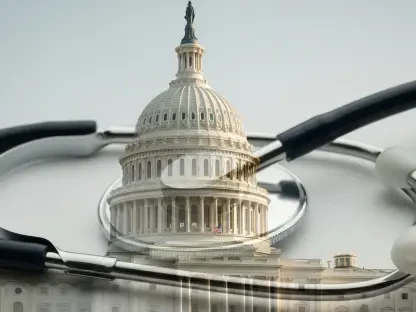Imagine a nation at a standstill, with federal offices shuttered, public services halted, and political leaders locked in a bitter standoff while rumors swirl about potential shifts in immigration policy, creating widespread concern and confusion across the United States. This is the reality facing the country during a government shutdown, the first in nearly seven years, which has sparked significant unrest. The federal government has firmly denied any changes to immigration laws or border enforcement, countering misinformation amid a crisis that has disrupted millions of lives. This event coverage delves into the unfolding drama of the shutdown, exploring its causes, impacts, and the political gridlock at its core, while shedding light on the critical stance on immigration policy.
Unpacking the Shutdown and Immigration Policy Stance
The government shutdown, triggered by a failure to pass a temporary budget, has brought non-essential federal operations to a grinding halt. This crisis, rooted in disputes over health subsidies and spending cuts, has affected countless sectors nationwide, with a particular focus on border security due to circulating rumors of policy relaxation. The U.S. government has explicitly stated that no alterations to immigration laws are under consideration, emphasizing the importance of clarity during such chaotic times.
The significance of this denial cannot be overstated, as misinformation has the potential to exacerbate public anxiety and strain already tense border regions. With essential services like Border Patrol continuing to operate despite unpaid staff, the government’s priority remains national security, even as other areas suffer. This situation underscores the broader impact of the shutdown, affecting vulnerable populations and disrupting daily life across the country, setting the stage for a deeper look into key developments.
Key Developments in the Shutdown Crisis
Official Position on Immigration and Border Security
Amid the chaos of the shutdown, the U.S. government has taken a resolute stand against rumors suggesting a loosening of immigration controls. Official statements, including posts from U.S. Immigration Official accounts on social media platform X, have reiterated that border security protocols remain unchanged and unauthorized crossings are still illegal. This firm messaging aims to curb false narratives that could encourage risky border activities during a time of reduced oversight in other areas.
The emphasis on policy continuity is backed by expert analysis confirming that border enforcement remains a top priority, even as other federal functions falter. This clarification is vital for maintaining public trust and ensuring that the shutdown does not inadvertently weaken national security. The government’s proactive communication highlights a commitment to countering misinformation with factual updates.
Political Stalemate and Partisan Clashes
At the heart of the shutdown lies a profound political deadlock between Republicans and Democrats, centered on disagreements over health subsidies and fiscal reductions. President Donald Trump has championed significant spending cuts, while Democratic leaders like Hakeem Jeffries and Chuck Schumer argue for the protection of social programs, accusing the administration of inflexibility. This clash of ideologies has fueled heated exchanges, with both sides trading barbs on social media platforms.
The rhetoric has grown increasingly sharp, with the White House and House Republicans claiming Democrats prioritize undocumented immigrants over American workers, while Democrats counter that Republican policies are to blame for the crisis. This partisan divide not only stalls budget negotiations but also deepens public polarization, making resolution seem elusive. The intensity of these debates reflects a broader struggle over the direction of governance in the nation.
Effects on Public Services and Communities
The shutdown’s impact on public services has been immediate and far-reaching, with non-essential operations like national parks, Smithsonian museums, and food assistance programs grinding to a halt. Federally funded preschool education and student loans have also been disrupted, leaving families and students in limbo. These closures have created tangible hardships, particularly for those reliant on government support for basic needs.
Essential services, such as air traffic control and postal operations, continue despite staff working without pay, adding strain to already overburdened systems. The human toll is evident in communities where public health efforts, including food safety inspections by the FDA, have been reduced to emergency responses only. This uneven impact raises concerns about the long-term effects on societal well-being and trust in government functionality.
Rising Concerns and Potential Long-Term Consequences
New dimensions of the crisis are emerging, with President Trump issuing warnings of permanent layoffs for federal workers if the shutdown persists. The Office of Management and Budget has also highlighted risks of lasting damage, pointing to delays in critical areas like training new air traffic controllers, which could jeopardize aviation safety. These threats introduce an unprecedented level of uncertainty compared to previous shutdowns.
Additionally, reduced oversight in public health sectors, such as the FDA’s limited capacity to prevent foodborne illnesses, poses significant risks to the population. The potential for these issues to persist beyond the shutdown’s resolution underscores the urgency of finding a solution. Such developments signal that the current crisis could have ramifications for public safety and government operations well into the future.
Reflecting on the Crisis and Future Implications
Looking back, the government shutdown revealed a nation grappling with deep political divisions, widespread service disruptions, and persistent misinformation about immigration policies. The U.S. government’s unwavering stance on maintaining strict border enforcement provided a counterpoint to rumors, while the crisis exposed the fragility of non-essential services and the resilience of essential operations under duress. The partisan rhetoric, amplified through digital platforms, painted a picture of a polarized political landscape where compromise seemed out of reach.
Moving forward, addressing this crisis demands a renewed focus on bipartisan dialogue to resolve budgetary disputes and restore federal functions. Policymakers must prioritize vulnerable communities hit hardest by the shutdown, ensuring that safety nets like food assistance and public health measures are swiftly reinstated. Additionally, strategies to combat misinformation, particularly regarding immigration, should be strengthened to prevent further public confusion. This event serves as a critical reminder of the need for systemic reforms to prevent future shutdowns, urging leaders to bridge ideological divides for the sake of national stability and public welfare.









